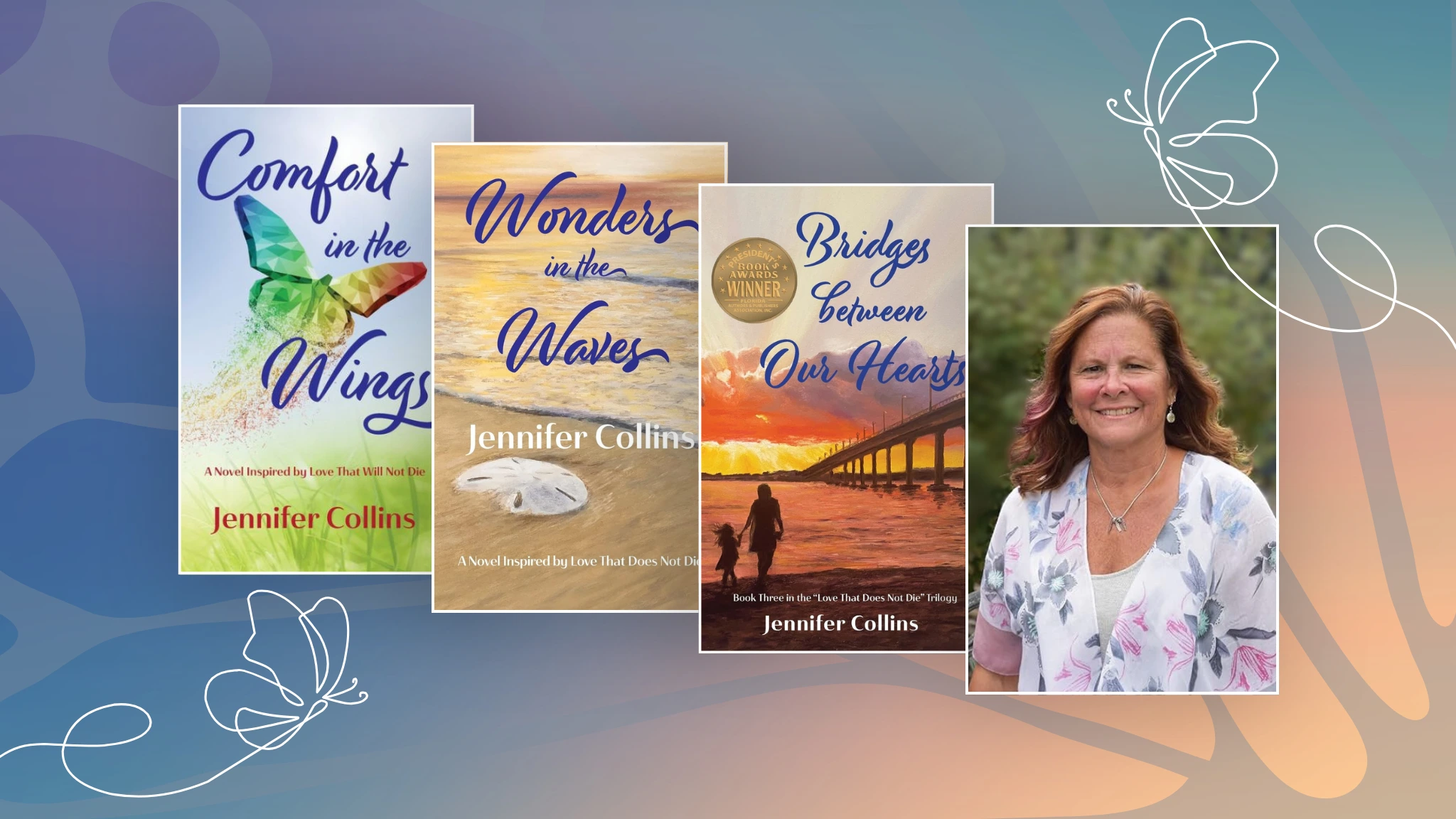“Grief can be isolating. It brings a sense of shame, the embarrassment that we are not strong enough to shake free of it. We make those around us uncomfortable because they don’t know what to say. They fall back on platitudes — “sorry for your loss” — or say nothing at all, thinking silence is showing respect, which intensifies the loneliness, the emptiness.”
With these words, author Jennifer Collins pins down the hard-to-define ache of grief — the way it detaches us from others, despite it being a fate we all must face at some point or another. It’s a topic she skillfully explores throughout her trilogy Love That Does Not Die — first in the debut, Comfort In the Wings, and then the following two, Wonders in the Waves and Bridges Between Our Hearts.
Now, Collins speaks with us about capturing the waves of grief and the enduring power of love within her writing. Read more below to see the thought process behind this poignant, inspiring series, and what she hopes readers take away from her story.
Q: Your Love That Does Not Die trilogy shares stories of loss, resilience, gratitude and new connections. Why did you choose these topics as the key themes in your work?
A: These themes are the very essence of human existence. While other aspects of our humanness such as romance are more often featured in fiction, I hope to shine a light on the very real forces that move us, that impact our day-to-day quality of life. In the throes of loss, finding one’s own powers of resilience, sense of gratitude and drive to make new connections can truly be the lifeline to surviving, and then ultimately, perhaps thriving.
Q: Your protagonist, Larissa, takes a journey through the anguish of grief in her resolve to live life to its fullest. How did you approach portraying grief in a way that feels both authentic and hopeful for readers?
A: One authentic way to portray grief is by including its often-described wave-like nature. There are days when the grief level is so intense, that one wonders how to put one foot in front of the other. There are also days (or hours or moments) when it abates to a barely detectable level, almost allowing one to open up enough to feel happy. Yet it is always there. Larissa discovers that grief and joy co-exist, and I believe that is an authentic portrayal. Knowing joyful moments are there to be found can create hope.
Q: The idea of building bridges is a powerful metaphor in this story. What inspired this theme, and how does it connect to the overarching message of the trilogy?
A: In the second book, Larissa is both challenged and elated to forge connections — build bridges — with a son she has never known. In the third book, this extends to making connections to people important in his life. Building bridges between different characters as well as across geographical barriers helped this metaphor to emerge. A song becomes very important in this book, and there are musical bridges as well. Another theme is whether is it possible to connect with those we have lost — for example, do they send us signs? Could seeing a rainbow be a bridge to them?
Q: By the third book, Larissa has undergone immense growth. How did you ensure her evolution felt natural and compelling across the trilogy, especially in this final installment?
A: The books are character-focused, providing deep insight into Larissa’s thoughts and feelings through her musings when she walks alone, by flashbacks and recounting of dreams, and in this book, excerpts from her diaries. Being part of her introspection helps the reader feel her growth. Another way that her evolution becomes apparent is through the eyes of her close friends. These characters are present throughout the trilogy and their interactions with Larissa change as she changes — as she moves from barely surviving in the first book, to helping others navigate challenges in their own lives and the world around them.
Q: The concept that “love does not die” is pivotal in the trilogy. How does Bridges Between Our Hearts deepen this message in ways the previous books did not?
A: This trilogy is about a mother’s love enduring beyond a child’s earthly life, as well as love for extended family and dear friends. In Bridges Between Our Hearts, Larissa is able to embody this in a way that extends into the next generation as her legacy to them.
Q: Larissa faces choices that could lead to connection or further loss. What do these moments reveal about human resilience and the capacity to heal?
A: At this point in her journey of enduring loss, Larissa is constantly alert for the potential pitfalls that further loss could bring. She is dedicated to supporting her family in a way that shows her devotion and commitment to them, truly a testimony to love that does not die under any circumstance that arises.
Q: Were there personal experiences or stories in your own life that shaped Larissa’s journey?
A: My personal experiences are the underpinnings of Larissa’s journey. As I did, Larissa continues on by finding beauty and joy in the smallest things, being grateful for precious memories, and cultivating meaningful connections with new friends. Moments such as a heart shaped beam of sunlight or Larissa holding a mug imprinted with a child’s drawing, come directly from my own memories.
On a less emotional level, my belief that travel is essential for learning about one another also shapes Larissa’s journey. In the throes of COVID, she finds ways to instill a love of travel in her granddaughter.
Q: Discuss the role that spirituality plays in your books.
A: Spirituality, in its most broad and inclusive form, plays an integral role in these stories. Throughout all three books, Larissa is searching to make meaning in her life after loss. She is also striving for ways to expand her world to include a son she has never lived with, as well as his daughter. Her moments meditating in both formal and informal settings are deeply spiritual in nature. Many readers have found this aspect of the stories to be comforting and inspiring.
Q: What do you hope readers will reflect on after finishing Bridges Between Our Hearts?
A: I hope that readers will reflect upon how to find and express gratitude, no matter how difficult or heart-breaking life may become. In finding a way to feel gratitude in even the smallest of things, a person will be able to go on in the face of adversity and loss. Similarly, I hope that Bridges Between Our Hearts inspires readers to reflect upon honoring connections with their loved ones by building bridges rather than allowing inconsequential events to divide them.
The Love That Does Not Die series is available for purchase on Amazon, Barnes & Noble and Bookshop.
RELATED POSTS:
Comfort In the Wings: A Poignant Look at the Loneliness of Grief and the Need for Human Connection
Wonders in the Waves: Explore Grief and Healing on a Mother’s Journey to Find Her Son
 Jennifer Collins, author, is a retired physical therapist and college professor. In recognition for her contributions as an author, she received the 2023 Literary Artist Award from the MartinArts Council. This award recognizes her fictional work honoring the dualities in life: grief and gratitude, sadness and hope, and most of all, the joy in each moment.
Jennifer Collins, author, is a retired physical therapist and college professor. In recognition for her contributions as an author, she received the 2023 Literary Artist Award from the MartinArts Council. This award recognizes her fictional work honoring the dualities in life: grief and gratitude, sadness and hope, and most of all, the joy in each moment.
Comfort in the Wings, an award-winning debut novel, emerged from enduring multiple, sudden deaths in her immediate family including two of her children, and her only sibling. Overcome with loss, she found comfort in signs that reminded her of her children, and hope from new connections. She found herself in awe at the outpouring of stories from other parents who had lost children. Wonders in the Waves, a sequel that also stands on its own, finds her main character gradually moving from mere survival to striving to thrive. The third in the series, Bridges Between Our Hearts, is the winner of the 2024 American Writing Awards and the F.A.P.A. President’s Award, both in the category for Inspirational Books. It is an inspiring, generation-spanning story that completes the Love That Does Not Die Trilogy. These heartwarming books bring a seldom heard voice to fiction.
Collins enjoys daily walks and writes from her homes in New York and Florida. Her appreciation for the healing qualities of being near the water inspired her to feature the Finger Lakes region of New York and Hutchinson Island, Florida, in her novels. Her characters find peaceful retreats in these unique, picturesque environments.

